Lessons from the sustainable strategies of the Tokyo 2020 Olympic Games
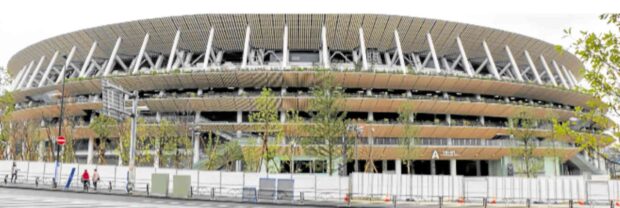
The Tokyo 2020 Olympic Stadium, developed with the concept of “forest stadium”, was designed by Japanese architect Kengo Kuma, completely rebuilt for the 2020 Games, and is considered as a symbol of considerable pride in Japan. (DESIGNBOOM)
(Second of two parts)
How did they do it? The Tokyo 2020 Olympic Games consistently recognized the importance of sustainability in every phase, from preparation until after the Games.
Hydrogen
Hydrogen produced from renewable energy sources in Fukushima was used in various situations at the Tokyo 2020 Games.
The cauldron for the opening and closing ceremony at the Olympic Stadium was fueled by hydrogen produced from renewable energy sources. Hydrogen is an energy source that does not emit carbon dioxide during use and is expected as one of Japan’s main strengths in advancing towards its climate goals. Hydrogen is an alternative fuel choice applicable for transportation and electricity generation applications.
Toyota Motor Corp. supplied 3,700 vehicles for the Tokyo 2020 Games. Ninety percent were electrified—hybrid electric vehicles, fuel cell electric vehicles, hydrogen powered Mirai, and plug-in hybrid electric vehicles. The rate of use of low-pollution and fuel-efficient vehicles was 95 percent—the best result achieved in the history of the Olympic Games.
Travel Demand Management (TDM)
The Tokyo 2020 Games were marked by smooth and efficient transport thanks to the TDM, which was implemented in collaboration with businesses and government. The system reduced vehicular traffic by about 20 to 30 percent, thus reducing the environmental impact.
Use of recycled materials
Part of the materials used for the torches were recycled aluminum previously used in the construction of prefabricated housing units in the aftermath of the 2011 earthquake and tsunami. Parts of podiums were made from recycled plastic such as detergent bottles.
During the Games, gold, silver, and bronze medals were produced from recycled post-consumer mobile phones and other electronics collected from all over Japan. This process of recovering rare metals in the discarded mechanical and chemical treatments is referred to as urban mining. Please refer to an earlier article I wrote on urban mining.
Recycling in new venues was conducted, achieving their target of 99 percent or higher rate. For existing venues, they achieved 99.6 percent rate of recycling.
Japanese timber
To achieve their sustainable venue construction goal, they used Japanese timber extensively. For the opening ceremony of the Olympic Games, wood from forest thinning was used.
Forest thinning is the selective removal of trees to improve the growth rate of the remaining trees. Thinning may be done to increase the resistance of overcrowded trees to environmental stress like drought, insect infestation, extreme temperature, or bush fire.
Greening of the venues
During the construction of the permanent venues, existing plants were incorporated from the earliest design stage. They also transplanted trees and new trees of native species, which are adapted to local environmental conditions, thus requiring far less water, and saving time and money. In addition, native trees supply habitat for birds and other wildlife benefits.
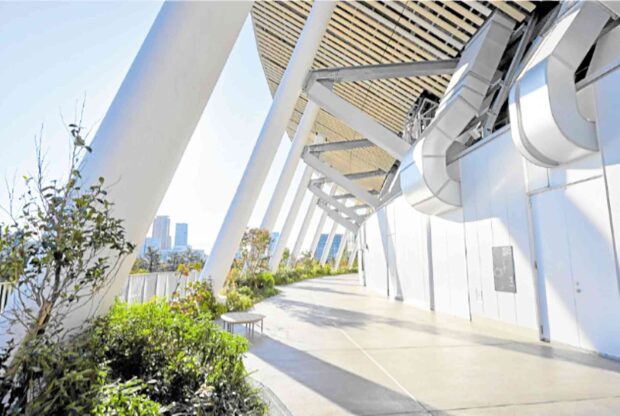
The Olympic Stadium’s intimate scale is achieved by stacking the eaves like the five-story pagoda of Horyuji Temple. The slightly upward-facing eaves make it easier to let the wind in.
Heat island effect
To address Tokyo’s heat island effect, the Greenway and Port Park were overhauled to allow residents to relate to nature after the Games.
To alleviate the heat sensed by the people, they created cool areas in the vicinity of the competition venues. They installed heat prevention systems such as eaves and misters to help cool down outdoor areas by spraying a fine mist of water that evaporates quickly and cools the surrounding air at public transportation facilities and other establishments.
Road surface temperature was reduced with solar-heat-blocking pavement installed on 5.6 km of national roads and 157 km of municipal roads.
Water circulation and quality
For some of the permanent venues, they installed systems that use rainwater, recycled water, or recirculated water.
For the competition venue for Marathon Swimming and Triathlon, they installed three-layer polyester underwater ‘screens’ to hold the flow of contaminants to protect water quality at the location where the triathlon and other open-water competitions were held.
To improve the waters in Tokyo, including rivers and seas, a facility to store dirty sewage, with a capacity of 1.5 million cubic meters, was built to reduce the pollutant load.
Venue development
There were three types of venues in the Tokyo 2020 Games. They were the existing venues, new construction, and temporary venues erected solely for the Games.
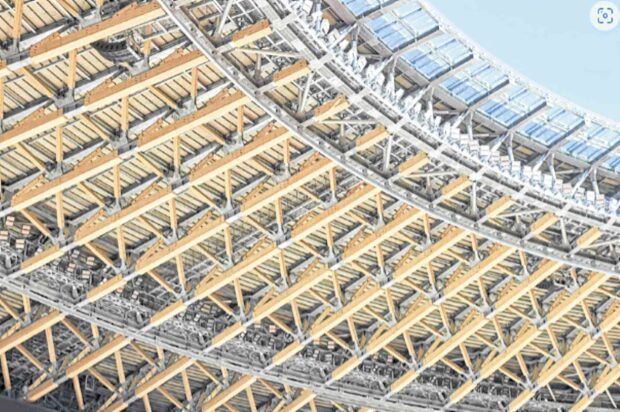
The Olympic Stadium’s wide roof eaves blocked direct sunlight from entering the stadium. The soft wood skin also has the effect of easing people’s stress and bringing mental stability
The Olympic Stadium
Developed with the concept of “forest stadium”, the Olympic Stadium, designed by Japanese architect Kengo Kuma was completely rebuilt for the 2020 Games and is considered as a symbol of great pride in Japan. The origin of this structure can be traced back to Horyuji Temple in Nara, the oldest wooden structure in the world.
Architect Kuma describes the area where the Olympic Stadium is found and the Meiji Shrine as a large sacred forest for Tokyo, whose spirituality is at the core of the city.”
The Olympic Stadium was the venue for the opening and closing ceremony of the Tokyo Games. It was used for sporting and cultural events and has a seating capacity of 68,000.
It was designed to take maximum advantage of the power of nature, using solar panels and rainwater to be used for toilets, among others. Wide roof eaves and wind terrace allow the winds in each season to flow through the building using natural ventilation to effectively flush out heat.
The trusses of the main roof were made from 2,000 cubic meters of certified timber sourced from each of Japan’s 47 prefectures to reduce the environmental impact.
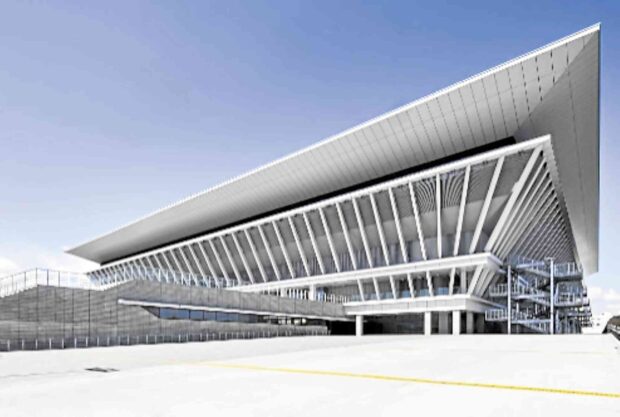
Ultramodern technology allows the 10-lane pool’s length and depth to be adjusted by moving floors and walls. The Tokyo Aquatics Center is powered by solar energy and a ground heat exchanger. (TOKYO AQUATIC CENTRE)
Tokyo Aquatics Center
Ultramodern technology allows the 10-lane pool’s length and depth to be adjusted by moving floors and walls. The building is powered by solar energy and a ground heat exchanger. The venue served as the center for Japanese swimming supporting aspiring world-class athletes, and the local community.
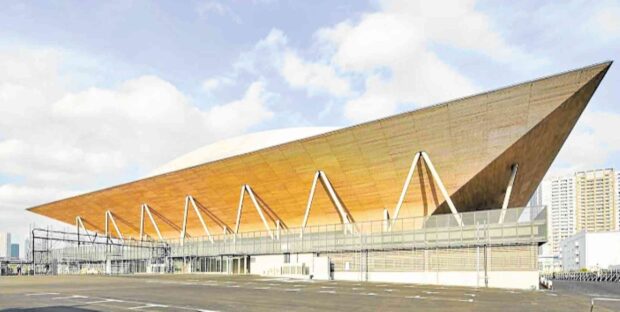
Ariake Gymnastics Center aims to showcase true Japanese craftsmanship and woodworking culture. It features the most extensive usage of timber across all Tokyo 2020 venues with 2,300 cubic meters of wood sourced from throughout Japan for the project and it boasts one of the largest timber roofs in the world. (DE51GN)
Ariake Gymnastics Centre
Designed by Architects: Nikken Sekkei, Shimizu Corp., the building was designed as a temporary venue using a large amount of timber for the beams, exterior and interior. It won an award in the Japan Council for Advancement of Timber Utilization 2020 competition. It got the highest rating under CASBEE in the design-stage evaluation as an exhibition venue.
Lessons learned.
The Tokyo 2020 Olympic Games is an outstanding model for development displaying the Japanese discipline and mindfulness particularly in the planning, implementing, and monitoring of sustainable principles in all aspects of the Games. This should not come as a surprise, as the overall culture of the Japanese values organization and cleanliness which contribute to keep things running smoothly.
Even if a country does not aspire to host a mega project like the Olympic Games, it still makes sense to understand and see how the Tokyo 2020 Olympic Games did it. Sustainability is going mainstream and that is the message that the Tokyo Games is trying to convey.
For the Philippines, with so many massive developments ongoing, the biggest challenge is not merely to develop new and charming cities and towns but to include sustainability in every phase of the project that addresses the needs of the community while protecting the environment.
The author is the Principal Architect of A.P de Jesus & Associates – Green Architecture. For comments or inquiries, email amadodejesus@gmail.com
